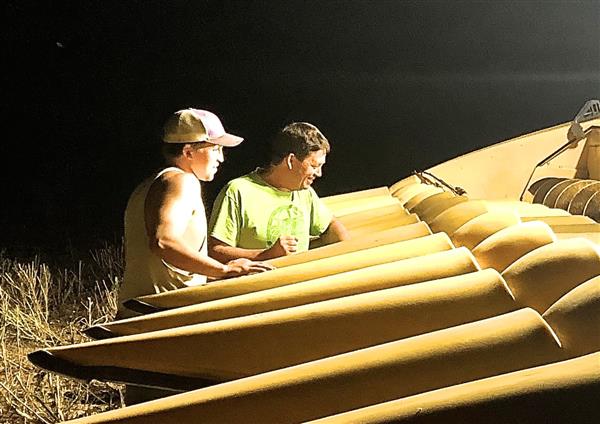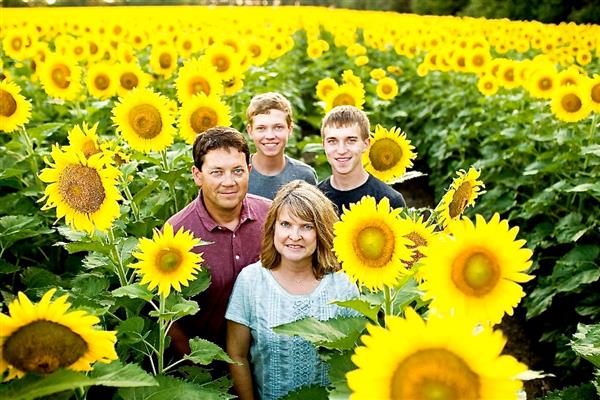Article Archives
Sunflower State Success Story
Monday, February 1, 2021
filed under: Planting Systems
 Connor (left) and Cameron (right) Peirce
Cameron Peirce’s first experience with producing sunflower, undertaken more than two decades ago, did not go very well. “I planted an 80 of sunflower, didn’t know the first thing about them — and they only made about 275 lbs/ac,” the Hutchinson, Kan., farmer recalls.
Connor (left) and Cameron (right) Peirce
Cameron Peirce’s first experience with producing sunflower, undertaken more than two decades ago, did not go very well. “I planted an 80 of sunflower, didn’t know the first thing about them — and they only made about 275 lbs/ac,” the Hutchinson, Kan., farmer recalls.
Fortunately, Peirce decided to give the crop another try several years later.
“We’ve been pretty serious [about ’flowers] the last 10-12 years and have had really good luck with them,” he says. The 2020 crop year was a prime example. He and son Connor planted about 1,000 acres of sunflower, and the majority of those acres came in between 2,400-2,700 lbs/ac. Their irrigated acreage, double cropped after wheat, yielded 2,700 lbs. “Around here, 2,000 lbs should be pretty attainable” most years, Cameron says.
Wheat and milo are the dominant crops in their area of south central Kansas, with soybeans and corn more secondary. The Peirces are among the largest sunflower producers in their vicinity. They grow oil-type varieties, focusing on the birdseed market.
Cameron’s commitment to the crop is underscored by his position as vice chairman of the Kansas Sunflower Commission, on which he has served for the past seven years.
Their biggest challenges with the production of sunflower? Weed control and Dectes stem borer.
“Weeds and sunflower don’t mix very well, so you have to pick and choose your fields carefully when going in with ’flowers,” Cameron affirms. “If you have a bad experience with weeds, it just leaves a bad taste. I tell everybody, pick your cleanest fields and go with those.”
Palmer amaranth is the primary weed problem for the Peirces, who are 100% no-till. About a month ahead of planting, they’ll apply Valor. After planting, they come back with a pre-emergence treatment of AuthorityElite. Should the weed population warrant it, they’ll finish with a postemerge application of Zidua.
Dectes stem borer is a frustrating insect pest for the Peirces. Cameron says it has, in some years, reduced their plant stands by 15% or more, girdling stems and dropping plant heads to the ground as lodging occurs. They deal with it in soybeans as well.
While they also contend with sunflower head moth, that one can be managed with insecticides. Not so with the Dectes stem borer, for which there are no currently labeled effective insecticide treatments. The Peirces try to tilt the odds in their favor in two ways: (1) by selecting hybrids that appear to have better tolerance to Dectes, and (2) trimming back on plant populations with the goal of producing larger, stronger plant stalks.
About 40% of the Peirce sunflower acreage goes in as a double crop after wheat. “Our wheat harvest is typically finished by the end of June,” Cameron notes. “So as soon as the combines are out of the field, Connor is out there planting sunflower — unless we first have to control some weeds.”
“That’s the beauty of sunflower,” Cameron adds. “We do have a bigger window if we don’t have enough moisture after [wheat] harvest. We planted on July 15 this past year with full-season ’flowers — and they made it without any problem.”
They also make extensive use of cover crops. While soil health is a definite benefit, a more-primary motive is wind and water erosion control on their diverse soils — which range from “silty clay to pure sand,” Connor points out. Their cover crop mix is mainly grass seed, with some legumes included. “We’ll drill it down in 7.5-inch row spacing, either in late fall or early spring,” he says.
They prefer to plant their sunflower while the cover crop is still green. “But the issue with that, sometimes, is that if we use Valor, it will ‘tie up’ on green residue,” Cameron notes. “So if the Valor is tied up with the residue and we need to put on another shot of PPO [inhibitor herbicide], it’s too much for the sunflower.”
“We’d also like our cover crops to help with weed control” through the weed suppression effect, he adds. “We’d really like to reduce our need for herbicides.”
When harvesting, the Peirces utilize a corn head converted for sunflower through the addition of an Arro® conversion system developed by Kopper Kutter of Cimarron, Kan., and distributed by ShieldAg of Hutchinson. They’ve cut about 2,500 acres of ’flowers with this system so far, and are pleased with its cutting efficiency and minimal seed loss.
Though not yet utilized with sunflower, Connor also developed a modified plot planter to experiment with relay cropping of winter wheat and soybeans. “Drilling wheat in the fall on 7.5-inch row spacing, I blocked off four rows and left four rows planting. So there’s a 30-inch swath of wheat and then a 30-inch space,” he explains. Managing it as he would a “normal” wheat field (top dressing, fungicide, etc.), he came back in late March/ early April and planted twin-row soybeans in the open spaces.
“So the wheat and soybeans were growing at the same time, together. Once the wheat was ready for harvesting, the beans still weren’t tall enough to be cut off by the cutter. We harvested the wheat like normal, and the beans continued to grow.”
The wheat strips — despite covering only half the acreage of the adjacent standard field area — produced just 5-10% less yield per acre than the standard field. “And those full-season soybean strips yielded just as well — maybe even a little better — than the rest of the beans did,” Connor reports.
He might expand the relay cropping experiment to include sunflower in the future under a full-season system, theorizing that having more outside rows will make up in yield for a good portion of the “missing” acreage. Key, of course, would be for the ’flowers not to be so tall at wheat harvest that their growing points would be clipped off.
 Peirce family in sunflower field (2018).
As a Kansas State University graduate (majoring in agronomy with an ag tech management minor), Connor carried on a Peirce family legacy — as has his brother, Hayden, a current K-State student. Both sets of Cameron’s grandparents and his own parents were K-State graduates, as is Cameron. However, Cameron married “across the line,” as he jokingly puts it. Jeanne, his wife and mom to Connor and Hayden, is an alumnus of the University of Kansas. — Don Lilleboe
Peirce family in sunflower field (2018).
As a Kansas State University graduate (majoring in agronomy with an ag tech management minor), Connor carried on a Peirce family legacy — as has his brother, Hayden, a current K-State student. Both sets of Cameron’s grandparents and his own parents were K-State graduates, as is Cameron. However, Cameron married “across the line,” as he jokingly puts it. Jeanne, his wife and mom to Connor and Hayden, is an alumnus of the University of Kansas. — Don Lilleboe